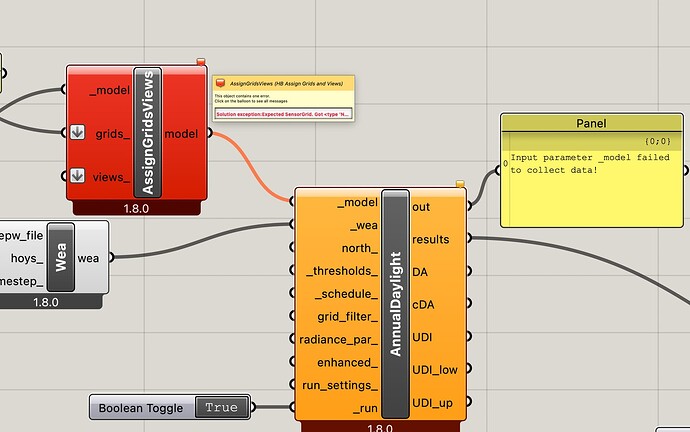Some of the tutorials I’ve seen online involve components not present in the latest ladybug/radiance/honeybee functions a new install creates in Grasshopper. I’m sure someone has a set of instructions but I’m painting myself into corners over and over trying to follow tutorials that don’t do what I want or that depend on prior versions of these tools.
I want to know the average annual lux of a plane a few feet above the floor of a structure previously created in Rhino; it’s got a variety of windows and glass doors and skylights that allow reflected light and I’m trying to tune the result so the interior isn’t too bright where it’s located. From the forums it seems I should be using HB Annual Sunlight Exposure and the LB Spacial Heatmap to create the visual I want for comparing lux on my target plane, but the HB Annual Sunlight Exposure function wants output from HB Annual Daylight and that function is throwing an error that the “model failed to collect data” and the _model input comes from HB AssignGridViews (the HB Model function wasn’t providing a sensor grid) and the HB SensorGrid function doesn’t seem to be generating a sensor grid from the Mesh Surface I established with the U Count and V Count I thought would fit my surface.
I am completely willing to believe I’m doing everything wrong. Does someone have an example of an interior surface reporting annual average lux so I can see what this should look like? I hesitate to post files because nothing I’m doing with any of the functions is providing me anything that looks like intended output do I feel it’d only confuse onlookers, though I’m happy to post what I’m working on if that’s of any utility.
I think that this sample file annual_daylight.gh you can download from github may be of use.
if not there are more radiance samples found here
I hope that helps!
-trevor
I looked at your Grasshopper file and it looks like I’m getting some flags yours does not produce. I tried turning a room-from-solid aperture from a “geometry” object to a “brep” like yours uses, and I’m still getting a “sub-faces were not matched with any parent Face” error, even though the aperture is coplanar with the face.
The tutorial doesn’t show anything about setting faces. Is there a trick to setting a parent face so the script will function? I’m really struggling to make even a simple test room with one window produce output.
Are you able to share a sample file so I can get a better Idea of what’s going on?
are your windows or doors touching the edge of the parent face? if your geometry is coplanar, that can be a cause of the error you are getting.
Like this:

I’ve got two that I’m working on, one that’s actually my intended project and one that’s a simple box room for testing to verify I can actually make a map of annual average lux over a floorspace at all anywhere, so I can tell where my errors are in my project. I do think I have a door that shares an edge in my test room file but a lot of the windows in my actual project are not sharing an edge. I tried attaching both, but the actual project is more than an order of magnitude too large to upload.
Sample_Room.zip (39.1 KB)
The Grasshopper file for the project is attached, in case the layout suggests obvious errors, but the Rhino file with the objects it references are too big to fit.
Lux_Ladybug.gh (60.1 KB)
The structure comes not from understanding but meticulous replication of the layout set forth in the tutorials here Geometry Preparation | Daylighting | Ladybug Tools Academy and I keep wondering if some of my errors flow from changes in version, or just things I’ve failed to notice. I’m not getting something that looks like a graph of average lux in my floor plan, and I’m not getting a legend added to my Rhino model, both of which I’d have expected from the behavior demonstrated in the tutorial 
I expect there’s something basic I’m missing, but the only resources at my disposal have advice on Climate Studio, which doesn’t run on my platform. I’d like to use Ladybug/Radiance in part because it supports my platform (and should be more reliably useful than something I kludge together to make something else run) and because I like the idea of using validated components to get results using tools I can use Grasshopper to leverage into more complex things as I learn more.
Thanks in advance!
Hi @Sea_Dragons I currently don’t have rhino 8 so I’m unable to open the files


